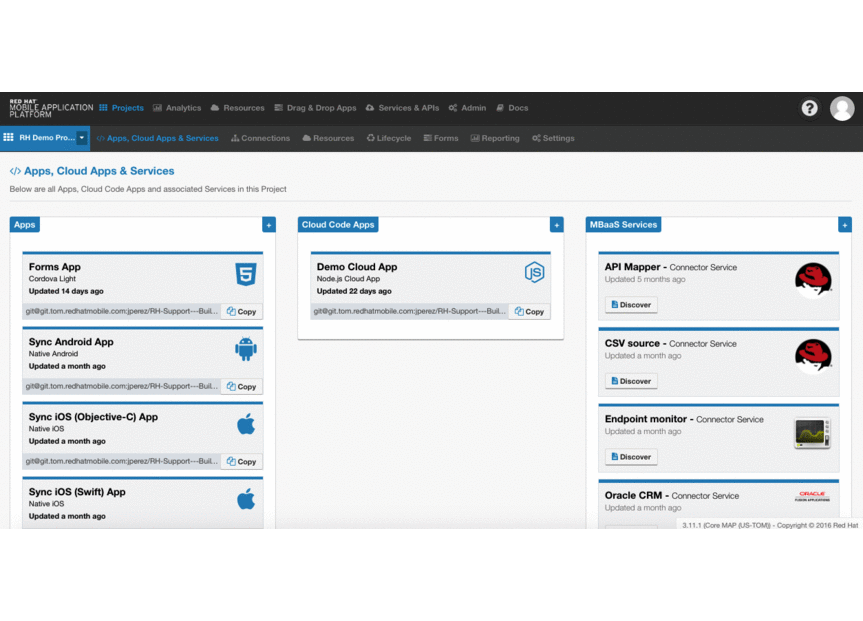Last June, we announced the availability of version 4.0 of our product. This was the culmination of months of hard work and demonstrated our constantly expanding set of capabilities. I went on to recap the key technology choices made over five years ago, choices that proved to be visionary for our mobile platform’s architecture and functionality: Node.js and containers. We are very proud of our accomplishments with Red Hat Mobile Application Platform 4.0 and the new technologies we introduced to our Mobile Backend-as-a-Service (MBaaS) component.
Well, now we are back again with another major announcement. Not only have we provided new underlying technologies for the important MBaaS component, but today, with version 4.2, we are launching our Core Mobile Application Platform running on the same foundation of Red Hat Enterprise Linux (RHEL) and Red Hat OpenShift Container Platform, leveraging docker formatted containers and Kubernetes orchestration for our entire product’s infrastructure. Starting today, we have a full Mobile Application Platform that can be installed on-premise, in private clouds or in public clouds and is fully supported from the ground up by our world-class Red Hat support team.
Our top-notch team of Engineers and Solution Architects is always happy to talk to you about our mobile platform architecture and technologies. We love to talk about all the goodness you get with Red Hat Mobile Application Platform (RHMAP): containers, security, microservices, JavaScript, Node.js, APIs, automation and, of course, mobile apps. However, first let me talk to you about the problems our product solves for you and your organization.
What problems does RHMAP solve?
RHMAP is about helping enterprises grow their mobile developments. As you start your mobile app development journey, eventually adding more apps, developers, backend integrations and mobile initiatives, not to mention third party system integrators it gets more and more difficult to control and manage parallel development and production activities. Processes become more complex. There is also a need to integrate with more data sources and the app development life cycle management becomes more challenging. RHMAP makes things easier for development teams; enterprises use it as a central point from which they can control, manage and monitor all activity, ranging from security in app development to reusability of services and components. RHMAP adds possibilities with “bring-your-own-tools” openness, and it enables developers mobile-specific functionality that means they do not have to reinvent the wheel on every project.
RHMAP enables enterprises to:
- Develop, integrate, deploy and manage multiple mobile projects
- Bring mobile apps to market faster
- Improve business efficiency and employee productivity
- Centralize security and management across all mobile projects
- Improve IT collaboration across developers and operations teams
- Access to world-class customer support
Around the world, it has become a strategy for businesses of all sizes to leverage mobile technologies and build mobile apps. With that in mind, the release we are announcing today takes mobile app development into the next generation, a world where the best technologies with DevOps enablement is possible.
Whether you want to build DevOps practices in your organization or you are already implementing them, RHMAP 4.2 is there for you to enable an environment in which building, testing and releasing apps happens quickly, frequently and, above all with reliability.
How RHMAP 4.2 helps with DevOps practices?
On-premise or in the cloud, RHMAP enables DevOps for faster app development and delivery. Here are a few examples:
- Server-side (cloud-side) apps and microservices are hosted in docker formatted containers that, with the click of a button, can be promoted to other environments such as testing, pre-production and production
- Kubernetes is the best technology to orchestrate apps and services that span multiple containers; using this orchestration, RHMAP provides resiliency, scalability and manages container health to detect and automatically restart containers experiencing failure
- Your apps hosted on pods of docker formatted containers make deployments more repeatable and secure, but you do not have to worry about the detail because RHMAP with the OpenShift Container Platform manages and ensures consistency in your deployments
- A large community ecosystem of Node.js modules can be quickly added to your apps in the MBaaS component, which speeds up development.
- Maintain a history of your app builds and deployments, debug with aggregated log files and monitor the health of your apps
- With RHMAP, full functionality extends to a command line interface (CLI), letting you automate your testing and deployments to make the best use of continuous integration, continuous delivery, and testing tools
All of these examples and more are possible with the architecture and new technologies released today on RHMAP 4.2. The move to Red Hat Openshift Container Platform also provides a common platform to support mobile apps running alongside traditional enterprise workloads already on OpenShift.
This release allows you and your business to become more agile. And no, you do not need to be in the public cloud to do DevOps. With a fully supported RHMAP product, you can move to the next generation of mobile app development with continuous application development running on containers, enjoying the reliability and security of Red Hat Enterprise Linux.
Last but not least, Red Hat is committed to providing customers with an exceptional experience. Red Hat has demonstrated its philosophy by taking ownership of every customer problem. The full value of a Red Hat subscription goes beyond the individual services to constitute a true working partnership.
Start exploring today, check for more details on our website or contact Sales at mobile@redhat.com
Last updated: October 31, 2023
